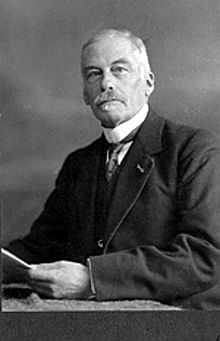Jan Cornelis Kluyver
Jan Cornelis Kluyver also: Kluijver (born May 2, 1860 in Koog aan de Zaan , † December 31, 1932 in Leiden ) was a Dutch mathematician .
Life
Jan Cornelis was the son of Albert Kluyver (* around 1831; † December 16, 1893 in Koog aan de Zaan) and Neeltje Dekker (* around 1831 in Wormerveer; † August 5, 1909 in Leiden). He attended the high school in Zaandam and passed his final exam there in 1876. In 1877 he became a student at the Delft Polytechnic , where he graduated as a civil engineer in 1881. From November 1881 he worked as a mathematics teacher at the Higher Citizen School (HBS) in Breda and from February 1891 as a teacher at the Higher Citizen School in Amsterdam . On June 28, 1892 he was appointed professor of mathematics at the University of Leiden, which task he began on September 28, 1892 with the introductory speech Beschouwingen over de nieuwere Algebra .
He taught algebra , analysis , function theory and probability theory and also dealt with differential geometry and number theory . With Korteweg and Schoute , he modernized mathematics teaching in the Netherlands. Among other things, he gave a formula for the Euler-Mascheroni constant and a formula that expresses the Stieltjes constants using Bernoulli polynomials. In 1905 he gave a solution to Karl Pearson's problem (posed in Nature 1905) about the radial probability distribution of a random path in two dimensions after n steps.
In 1896 he received an honorary doctorate from the University of Groningen , in 1897 he became a member of the Royal Dutch Academy of Sciences and was knight of the Order of Dutch Lions . In 1909/10, as the rector of the Leiden University, he also participated in its organizational tasks, for which he gave the rector's speech De gestadige vervorming der Wiskunde (freely translated into German: The constant change in mathematics) on February 8, 1910. Hendrik Kloosterman and Johannes van der Corput are among his doctoral students . Kluyver was editor of the Nieuw Archief voor Wiskunde . At the age of 70, he retired on September 15, 1930.
family
Kluyver married on December 27, 1883 in Koog aan de Zaan with Marie Honigh (* around 1859 in Zaandijk, † December 31, 1928 in Leiden), the daughter of Adriaan Cornelis Honigh and Clasina Dekker. There are children from the marriage. We know of these:
- Albert Jan Kluijver (born June 3, 1888 in Breda; † May 14, 1956 in Delft), was also married to a professor on July 29, 1916 with Helena Johanna Lutsenburg Maas
- Clasina Albertina Kluijver (born September 23, 1884 in Breda; † October 7, 1974 in The Hague) married on October 17, 1907 (divorced February 2, 1920) to Benjamin de Jong van Beek en Donk
- Nelly Margaretha Maria Kluyver (born July 4, 1891 in Amsterdam) married. October 8, 1913 in Leiden Adrianus Pijper (born March 11, 1886 in Kimswerd, † January 12, 1964 in Pretoria)
- Marie Johanna Kluyver (born June 17, 1894 in Leiden) married Abraham Everardus Jacob Simon Thomas (born March 9, 1892 in Leiden) on May 7, 1918 in Leiden.
literature
- Onze Hoogleeraren. Portraits and biographies. Nijgh & van Ditmar, Rotterdam, 1898, p. 48
- How is that? Vivat, Amsterdam, 1902, p. 250
- W. van der Woude: JC Kluyver. In: Jaarboekje voor Geschiedenis en Oudheidkunde van Leiden en Rijnland. PJ Mulder, Leiden, 1933, Vol. 25, pp. LXII-LXIII
- PROF. DR. JC KLUYVER †. In: Leidsch Dagblad. January 2, 1933 ( online )
Web links
- Some publications
- Kluyver at the Royal Dutch Academy of Sciences
- Kluyver in the professorial catalog of the University of Leiden
Individual evidence
- ^ Biographical entry in Dirk van Dalen The selected correspondence of LEJ Brouwer , Springer 2011
- ↑ Euler's constant and natural numbers, Proc. KNAW 1924, 142, pdf , Integer Sequences
- ↑ On certain series of Mr. Hardy, Quarterly J. Pure Appl. Math, 50, 1927, 185-192
- ↑ Weisstein, Stieltjes Constants
- ↑ See Paul Nahin Mrs. Perkin's Electric Quilt , Princeton University Press, 2009, p. 260. John William Strutt, 3rd Baron Rayleighm ( Rayleigh distribution ) answered the question for capital n, another for n = 3, Pearson himself stated that he only knew the answer for n = 2
- ↑ Jan Cornelis Kluyver in the Mathematics Genealogy Project (English)
| personal data | |
|---|---|
| SURNAME | Kluyver, Jan Cornelis |
| ALTERNATIVE NAMES | Kluijver, Jan Cornelis |
| BRIEF DESCRIPTION | Dutch mathematician |
| DATE OF BIRTH | May 2, 1860 |
| PLACE OF BIRTH | Koog aan de Zaan |
| DATE OF DEATH | December 31, 1932 |
| Place of death | Suffer |
